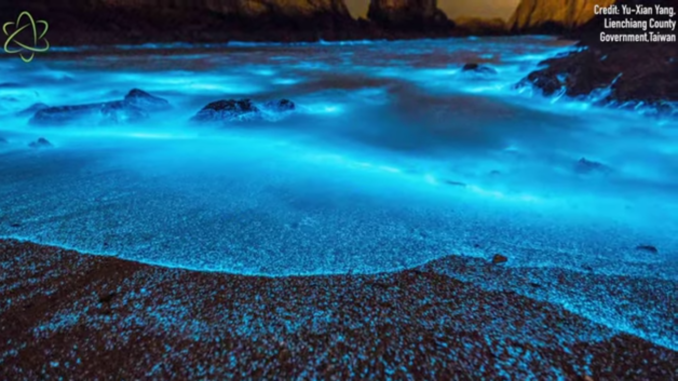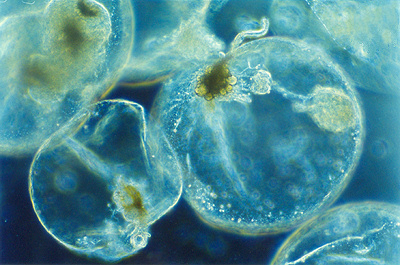
China’s Yangtze River empties into the Strait of Taiwan, between the East China Sea and the South China Sea. The region is well-known for it’s ‘blue tears’, which peaks in the Spring and rounds out Summer. The phenomenon can be found in other locations around the world, but this area boasts the largest bloom anywhere. Of course, that makes China’s blue tears a tourist atttraction. Elsewhere, the blooms are known as ‘milky seas’, ‘mareel’, or ‘sea sparkle’.
The beautiful bioluminescent glow is caused by single-cell dinoflagellates of the species Noctiluca scintillans. They emit the blue light when disturbed, such as in rough surf, or when a vessel plowing through their bloom causes a wake. Often referred to as algae, this single-celled creature is similar to both brown algae and diatoms. It feeds on a variety of organism such as other dinoflagellates, diatoms, fish eggs, plankton, and bacteria. However, their favored meal is actually a toxic algae that causes N. scintillans to excrete ammonia and chemicals poisonous to marine life. A large bloom of these dinoflagellates can also consume most of the oxygen in the water around them, depriving other sea creatures and causing fish kills. Note that N. scintillans is the same species that causes red tides.

Scientific classification
Domain: Eukaryota
Phylum: Dinoflagellata
Class: Dinophyceae
Order: Noctilucales
Family: Noctilucaceae
Genus: Noctiluca
Species: N. scintillans
Recently a study was conducted in which scientists utilized satellite data and found that the bioluminescent light produced by this creature is a very specific wavelength unique to N. scintillans. Published June 12, 2019, In Search of Red Noctiluca scintillans Blooms in the East China Sea also found that the blooms of blue tears were greater before and after construction of a dam on the Yangtze between 2000 and 2003. They suspect but have not confirmed that the decrease in the river’s flow during the dam’s construction indicates that fertilizer runoff from agriculture operations in China is brought by the river to the sea. The excess nitrogen fertilizer feeds the toxic algae that N. scintillans loves to munch on, resulting in larger blooms than would ordinarily occur in nature. This would mean that Chinese agriculture is using too much fertilizer. If true, they’re wasting alot of it which ends up in the ocean where it causes environmental damage in the form of destroyed marine life.
Blue tears, indeed.
Question of the Night: Ice tea or ice coffee or other in the Summer?
